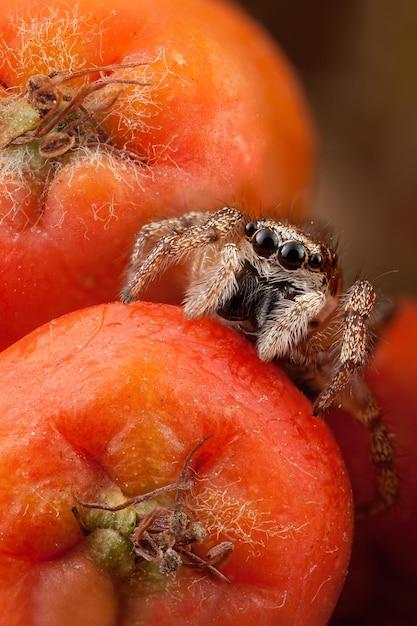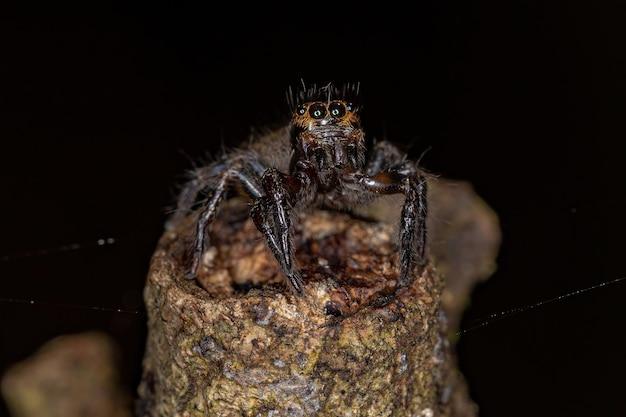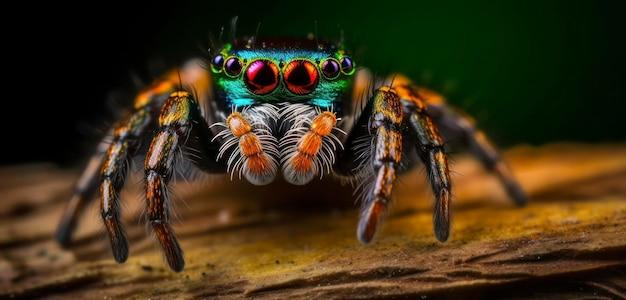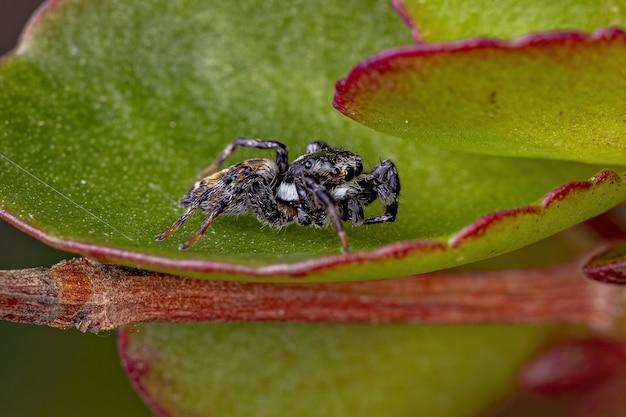Did you know that the world of spiders is home to a variety of species, each with its own unique characteristics? Among them, jumping spiders stand out for their incredible agility and captivating behaviors. But have you ever wondered how long these impressive creatures live? In this blog post, we will explore the lifespan of jumping spiders, including fascinating details about different species and how they fare both in the wild and in captivity. So let’s dive into the captivating world of these mesmerizing arachnids and unravel the secrets behind their lifespan!
Jumping Spider Lifespan: How Long Do These Adorable Acrobats Live
Jumping spiders, those cute little bundles of energy, have captured the hearts of arachnid enthusiasts and casual observers alike. With their impressive jumping ability and curious expressions, it’s easy to see why they are often considered the acrobats of the spider world. But have you ever wondered how long these tiny daredevils actually live? In this section, we will explore the jumping spider lifespan, shedding light on the secret lives of these captivating creatures.
A Leap Through Time: The Average Jumping Spider Lifespan
As with many aspects of nature, the lifespan of jumping spiders can vary depending on several factors, such as species, environment, and overall health. On average, jumping spiders tend to live for about one to two years. Now, that might not seem like much, but in the world of spiders, it’s actually quite impressive.
Species Spotlight: The Bold Jumping Spider
One particular jumping spider species that has gained significant attention in recent years is the bold jumping spider (Phidippus audax). These charismatic jumpers are known for their flashy appearance and fearless nature. But when it comes to their lifespan, the bold jumping spider follows the general trend of one to two years.
The Secret to Spider Longevity
So, what contributes to the relatively short yet action-packed lifespan of jumping spiders? Well, it turns out that the spider’s life cycle plays a significant role. Jumping spiders go through a fascinating transformation, starting as eggs, then hatching into spiderlings, and finally reaching adulthood. Due to their active lifestyle and constant hunting, jumping spiders may encounter a range of predators and environmental challenges, which can impact their longevity.
Spider Days: A Life Filled with Adventures
While jumping spiders may not boast the longest lifespans in the animal kingdom, they certainly make the most of their time. From the moment they hatch, these little daredevils are on the move, exploring their surroundings with unparalleled curiosity. Their incredible vision and agility enable them to hunt down prey, engage in complex courtship rituals, and even challenge their fellow spiders to daring duels (okay, maybe not exactly duels, but they are quite territorial!).
The Circle of Life: Reproduction and Beyond
For jumping spiders, reproducing is a top priority during their relatively short lives. Males often go to great lengths to impress potential mates, performing intricate dances and displays to win the affection of a female spider. Once successful, the male jumps on the opportunity (quite literally) to fertilize the female’s eggs. And just like that, a new generation of acrobatic spiders begins.
Cherishing Our Eight-Legged Companions
So, the next time you spot a jumping spider gracefully leaping from leaf to leaf or peeking at you with those adorable eight eyes, remember that their time on this earth may be short but jam-packed with adventures. These acrobats of the spider world may only live for a year or two, but they manage to captivate our hearts and remind us to embrace the joy of living every moment to the fullest.
In conclusion, the jumping spider lifespan may be relatively brief, but their impact on our hearts and fascination with their incredible feats is everlasting. So, next time you encounter one of these tiny daredevils, take a moment to appreciate their unique existence and the joy they bring to our lives.
Regal Jumping Spider Lifespan
Jumping spiders are fascinating creatures, and the regal jumping spider (Phidippus regius) is no exception. Let’s dive into the enchanting world of these tiny arachnids and explore their remarkable lifespan.
The Secret to the regal jumping spider’s long life
The regal jumping spider, with its vibrant colors and charming personality, has captivated many arachnid enthusiasts. One of the secrets to its impressive lifespan lies in its ability to adapt and thrive in various environments. These clever spiders can be found in different habitats across North America, from woodlands to gardens and even urban areas.
A Jumping Spider that outlives those trendy sneakers
Now, you might be wondering, “How long do these regal jumpers live?” Well, hold onto your hats because these tiny acrobats can live for up to three years! That’s right. While most spiders have relatively short lifespans, the regal jumping spider defies the odds and outlives the expiration date of that trendy pair of sneakers sitting in your closet.
You’re never too old to jump
Age doesn’t seem to slow down these sprightly arachnids. Even as they mature, regal jumping spiders retain their incredible jumping abilities, thanks to their astonishing vision and lightning-fast reflexes. Whether it’s pouncing on unsuspecting prey or impressing their spider pals with gravity-defying moves, these spiders know how to stay forever young in the game of life.
What shapes the lifespan of the regal jumping spider
Like most living organisms, the regal jumping spider’s lifespan is influenced by various factors. Genetics, diet, environmental conditions, and predation risks all come into play. Researchers believe that individuals with better access to food resources and safer habitats may have increased chances for longevity. So, a well-fed spider with a cozy home is likely to enjoy a longer life of adventures.
Living the spider dream
Imagine being a regal jumping spider, leaping from leaf to leaf, exploring the world with eight curious eyes, and hunting down insects like a true predator. Life as a regal jumping spider may be short compared to humans, but these fascinating creatures make the most of every precious moment they have. They remind us that it’s not the quantity of days that matters, but the quality of experiences we gather along the way.
So there you have it—a glimpse into the long and adventurous life of the regal jumping spider. With its vibrant colors, extraordinary jumping prowess, and impressive lifespan of up to three years, this spider certainly leaves its mark in the arachnid kingdom. But let’s not forget, while their lives may be short, these remarkable little creatures remind us to make the most of every day and appreciate the wonders of our own world.
Is it OK to Hold a Jumping Spider
Jumping spiders are fascinating creatures that captivate the hearts of many. Their curious nature and adorable, tiny eyes make them incredibly appealing. It’s no wonder that upon encountering a jumping spider, one might feel the urge to hold and interact with it. But is it really okay to hold these little acrobats? Let’s find out.
The Spider Whisperer
Now, before you grab your jumping spider and start planning your circus act, it’s important to know that not all spiders are fond of human contact. While some people have developed close relationships with their eight-legged friends, it’s generally not recommended to hold wild jumping spiders. These critters are best admired from a respectful distance.
Tiptoe with Caution
Jumping spiders are agile and quick, hence their name. They love to bounce around and explore their surroundings. When you try to hold them, there’s a chance they might perceive your intentions as a threat and attempt an Olympic-level leap to freedom. So unless you’re a seasoned spider whisperer, it’s best to play it safe.
Respect Their Personal Space
Jumping spiders, like any living creature, thrive best when given space and freedom. Their little spider lives are filled with hunting, exploring, and doing spider-y things. By holding them, you could potentially stress them out or even inadvertently harm them. So, it’s better to leave them to their spidery business.
The Exception: Pet Spiders
Now, before you lose all hope of ever holding a jumping spider, there’s a glimmer of light at the end of the web. Some jumping spider enthusiasts keep these fascinating critters as pets. Pet spiders are usually accustomed to human interaction from a young age and tend to tolerate being held better than their wild counterparts.
Spider Etiquette
If you decide to keep a jumping spider as a pet, always remember to treat them with the utmost care and respect. Wash your hands before handling them, ensure a safe environment, and keep the handling sessions short and infrequent. Remember, even though they might look cute and harmless, they are still delicate creatures.
While holding a jumping spider might seem tempting, it’s best to appreciate them from a distance. Respect their personal space and observe their incredible behaviors without disturbing their natural habitat. And hey, who needs to hold them when you can marvel at their acrobatic prowess as they gracefully leap from leaf to leaf? Keep your distance, enjoy their beauty, and let these little spider gymnasts do what they do best – be fascinating!
Now that we’ve explored whether it’s okay to hold a jumping spider, let’s dive into the longevity of these incredible creatures.
Jumping Spider Lifespan in Captivity
Jumping spiders are fascinating creatures known for their incredible jumping abilities and unique hunting techniques. If you’re considering keeping a jumping spider as a pet, one important factor to consider is their lifespan in captivity. Let’s dive into the world of pet jumping spiders and explore how long these tiny acrobats can live under human care.
Factors Affecting Lifespan
Before we reveal the secret to extending a jumping spider’s lifespan, it’s essential to understand the factors that can impact their longevity. While jumping spiders have relatively short lifespans, ranging from a few months to a few years, you can take steps to ensure they live their best spider lives.
1. Enclosure Size and Design
Creating a comfortable living space for your jumping spider is paramount. Make sure the enclosure is sized appropriately, allowing them enough room to explore, hunt, and spin their miniature webs. Spider architects need their space too!
2. Diet and Nutrition
Like any living creature, a jumping spider needs a balanced diet to thrive. Ensure they have access to a variety of small insects, such as flies, crickets, or even tiny beetles. Think of it as hosting a never-ending buffet for your eight-legged friend.
3. Environmental Conditions
Regulating the environment in the spider’s enclosure is crucial. Maintain a temperature range between 70-80°F (21-27°C) and humidity levels around 50-60%. Help them create a cozy home where temperatures are just right, and the moisture is at spider-approved levels.
The Moment of Truth: How Long Can They Live
Now, the burning question: how long do jumping spiders live in captivity? Brace yourself; it’s time for the truth. On average, jumping spiders can survive anywhere from a few months to a couple of years when well cared for in captivity. Don’t worry; those months will be filled with amusing spider antics, awe-inspiring jumps, and adorable moments you’ll cherish forever.
A Powerhouse of Short-Lived Fun
With their high-energy personalities and curious nature, jumping spiders pack a lifetime of adventures into their relatively short lives. They’ll play hide-and-seek, perform breath-taking jumps, and even engage in friendly staring contests (spoiler: the spider usually wins).
Making Every Spider Second Count
Although jumping spiders have a limited lifespan in captivity, fret not—each moment spent with these tiny terrors (in a good way) is full of excitement. So, make the most out of their time by observing their hunting prowess, marveling at their vivid colors, and appreciating their distinct personalities.
Cherish the Leggy Marvels
Remember, the key to building a strong bond with your jumping spider lies in providing a nurturing environment and heaps of love. Cherish the time you have together, watch them grow, and celebrate their spidey victories. Who knows, you might just discover a newfound appreciation for these incredible creatures and the joy they bring into your life.
Now that you’re equipped with the knowledge of a jumping spider’s lifespan, it’s time for you to embark on this captivating journey of pet ownership. So, get ready to welcome these bold and bouncy buddies into your world and brace yourself for some leaps of joy along the way. Happy spider parenting!
What is the Longest Living Jumping Spider
Jumping spiders are known for their remarkable agility, fascinating hunting techniques, and tiny but mighty bodies. But have you ever wondered how long these charismatic arachnids can live? In this section, we will dive into the mysterious world of jumping spider longevity and discover which species takes the crown for the longest lifespan!
The Ageless Wonder: A Closer Look at Spider Lifespan
Before we leap into the specifics, let’s take a moment to appreciate the marvels of spider lifespans. Now, we all know spiders undergo a magical transformation from adorable spiderlings to well-toned adults. But did you know that their lifespan varies greatly depending on several factors?
As with humans, genetics play a crucial role in determining how long a jumping spider can live. Some species hit the spider jackpot and are blessed with a longer lifespan, while others might feel a bit short-changed in the temporal department. Other factors that influence lifespan include habitat, availability of food, and overall spider health. So, without further ado, let’s uncover the jumping spider with the grandest lifetime achievement!
The Guinness World Record Holder: Holosysticus harringtoni
Drumroll, please! The species that takes the title for the longest living jumping spider goes to… Holosysticus harringtoni! These extraordinary creatures can potentially live for up to three years. Yes, you read that right – three glorious years of spider life.
Native to the coastal areas of North America, Holosysticus harringtoni is recognized for its distinctive appearance and exceptional longevity. Despite its advanced age, this spider doesn’t trade in its youthful energy for knitting crochet doilies or pursuing a career in web design. Instead, it continues to roam its territory, hunting and leaping with grace, delighting arachnophiles and entomologists alike.
The Secrets to their Longevity
Now that we know Holosysticus harringtoni takes home the trophy for the longest living jumping spider, you might be wondering how it manages to maintain such an extended lifespan. Well, let’s uncover the secrets behind this impressive achievement, shall we?
Firstly, these spiders are master self-care enthusiasts. They meticulously groom their bodies, ensuring their exoskeleton remains in excellent condition. This grooming ritual helps defend against predators, reduces the risk of infection, and keeps them looking sharp even in their retirement years.
Secondly, a balanced diet is a key ingredient in their longevity formula. Just like a healthy dose of kale and quinoa works wonders for us, jumping spiders thrive on a diverse menu of insects. Feasting on a variety of prey ensures they receive all the necessary nutrients to keep their tiny bodies lively and energetic. Plus, with such an extensive menu to choose from, they never get tired of the same old bug burger.
Wrapping Up
There you have it – the remarkable longevity of the Holosysticus harringtoni, a true inspiration for all jumping spiders out there dreaming of reaching the ripe old age of three! Remember, while not all jumping spiders can break the three-year barrier, each one has its own unique lifespan story to tell. So, the next time you stumble upon a jumping spider in your garden or on a hiking trail, take a moment to appreciate the incredible journey they’ve had and the dedicated grooming sessions they’ve performed to maintain their sprightly appearance.
How Long Do Jumping Spiders Live in Captivity
Jumping spiders are fascinating creatures known for their incredible energy and adorable faces. If you’re thinking about keeping a jumping spider as a pet, one important question you might have is: How long do jumping spiders live in captivity? Well, hold on to your arachnid hats because we’re about to find out!
Understanding the Lifespan of a Captive Jumping Spider
While the lifespan of jumping spiders in the wild can vary greatly, their longevity in captivity tends to be more consistent. On average, jumping spiders can live anywhere from 6 months to 3 years when properly cared for. That’s right, you could potentially have a spidey companion for longer than your favorite pair of socks!
Factors That Influence Lifespan
Like most living creatures, the lifespan of a jumping spider can be influenced by various factors. Here are a few key factors that can affect how long your jumping spider lives:
1. Species
Different species of jumping spiders have different lifespans. For example, the bold jumping spider (Phidippus audax) has been known to live up to 3 years in captivity, while the zebra spider (Salticus scenicus) typically lives for just 6 to 9 months. It’s like a game of spider roulette, but with longer odds!
2. Environment
Creating a suitable environment for your jumping spider is crucial for its longevity. Providing a spacious enclosure with plenty of hiding spots, climbing surfaces, and natural lighting can help mimic its natural habitat and promote a healthier, stress-free life. Plus, you’ll enjoy watching your agile little friend explore its new digs!
3. Diet and Nutrition
Jumping spiders are carnivorous predators, meaning they love a good feast of insects. To keep your jumping spider healthy and happy, offer it a diet of small live insects like fruit flies, crickets, and moths. Just imagine the joy on your spider’s face as it hunts down its next meal, like a miniature ninja!
4. Stress Levels
Stress can significantly impact the lifespan of any creature, and jumping spiders are no exception. Avoid sudden temperature changes, excessive handling, and loud noises, as these can stress out your eight-legged pal. Remember, a calm and stress-free spider is a happy and long-lived spider!
The Circle of Spidey Life
Now that you know how long jumping spiders can live in captivity and the factors that influence their lifespan, you’re ready to embark on a journey of spider stewardship. Embrace the joy of observing their incredible acrobatics, their impressive hunting skills, and their charming little personalities. So, go forth and become the best spider parent you can be – your jumping spider will thank you with its adorable faces and vibrant dances!



